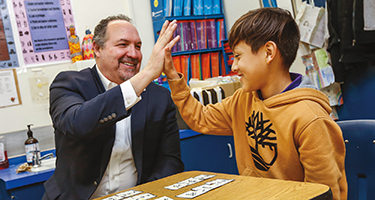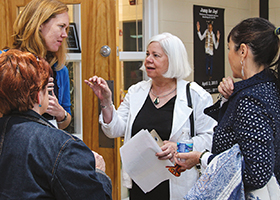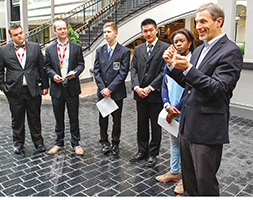
|
As superintendent in El Paso, Texas, Juan Cabrera shifted the district focus to prepare well-rounded school graduates. PHOTO COURTESY OF EL PASO, TEXAS, INDEPENDENT SCHOOL DISTRICT
|
Agility was the editorial theme for
GettingSmart.com last February. We thought the rise of artificial intelligence and the changing nature of work, the demands from the climate crisis to go green and prepare for extreme weather events, the opportunity of new personalized and competency-based learning models, and shrinking enrollments and new competition justified a focus on agile school leadership.
Little did we know the world would change a month later. Our school buildings were closed by a global pandemic, and we shifted gears quickly to remote learning. Preparing to resume education this fall with a mixture of remote and hybrid learning created unprecedented demands for agile leadership and nimble systems.
Agility’s Moment
In fall 2017, the nonprofit advocacy group America Succeeds released a report called “The Age of Agility.” It illustrated how we are in the early stages of a rapidly accelerating revolution that will bring automation and artificial intelligence into all sectors of the work-force. To thrive in the future, everyone will need an entrepreneurial mindset — feeling confident in uncertainty, embracing flexibility, identifying opportunities and delivering value for customers and communities.
After a two-year “Agility Tour,” which included community conversations in nine states, Tim Taylor, executive director of America Succeeds, said: “Three R’s are table stakes now. The 4 C’s are the currency of the future.” (He was referring to critical thinking, collaboration, creativity and communication.)
Taylor’s Agility Tour uncovered three big ideas:
»Learners need agility to manage their own learning and confidence as they apply analytical and design skills to new complex settings;
»Education systems must become agile and responsive to learner, employer and community needs; and
»Educators need to develop agility and be valued and empowered to succeed in a rapidly changing workforce.
These ideas already are taking shape in a few school districts.
 |
| Pam Moran (second from right) became expert in navigating across boundaries as the superintendent in Albemarle County, Va. PHOTO COURTESY OF ALBEMARLE COUNTY, VA., PUBLIC SCHOOLS |
Agile Learners
Agile systems adopt a learner-centered approach starting with goals that prioritize agency. A great example is the Loudoun County Public Schools, an 83,000-student district in Northern Virginia where the mission is “Empowering all students to make meaningful contributions to the world.”
Superintendent Eric Williams led community conversations that resulted in updating district aims. He believes in “engaging students in solving authentic problems as a means to developing knowledgeable critical thinkers, communicators, collaborators, creators and contributors.”
Having students focus on authentic problems can be “a game-changer,” he says. “Ownership leads to persistence. Learning will be deeper. … When learners see themselves as entrepreneurs now, when there is a real audience for work, they see a future for themselves.”
Loudoun County is adding learning opportunities outside of school connected to learning in school. These include senior-year capstone experiences in which young people have a choice where they’ll work.
Pam Moran, the former superintendent in Albemarle County, Va., worked to shift her schools from places where “content-driven, adult-determined teaching was the old norm” to places where “context-driven, child-determined learning is the new norm.” In her co-authored 2018 book,
Timeless Learning: How Imagination, Observation, and Zero-Based Thinking Change Schools, she described the goal of producing graduates who exhibited agile thinking.
“Everything we do around children, everything we say, every space we construct, every schedule we apply, every rule we make either opens learning up to children or creates limitations, filters and sorting mechanisms,” Moran says.
She encourages universal design for learning, choice and comfort, maker opportunities, interactive tools and connected learning.
In El Paso, Texas, superintendent Juan Cabrera hosted community conversations that resulted in a portrait of problem-solving graduates and a focus on active learning. The culture is student-centered, growth-focused, community-connected, agile and entrepreneurial. Cabrera shifted the focus from narrow measures of success to focusing on the whole child. As their site explains, “This approach seeks to assure EPISD graduates are academically prepared, well-rounded, civic-minded young citizens.”
El Paso worked with New Tech Network to develop 10 project-based academies that kickstarted districtwide transformation. New Tech learners build and receive feedback on their level of agency and collaboration expressed in each project.
Agile Systems
When he became superintendent in St. Vrain Valley School District in Longmont, Colo., 13 years ago, Don Haddad began developing a team and building community support to work collaboratively on a comprehensive mission to provide a strong competitive advantage for every student. In addition to a can-do attitude, the leadership team urged a shift in the focus from asking “What could our community do for us?” to “What could we do for our community?”
The 32,000-student district pushes academic excellence with an aligned system and a strong technology infrastructure, Haddad says.
One sign of agility in St. Vrain is the Innovation Center, a next-generation career center offering advanced opportunities in coursework, research and workplace experiences in content areas ranging from aeronautics, robotics, computer science and technology to media, STEM and entrepreneurship. In its third year of operation, the 50,000-square-foot center serves up to 750 students in nine career pathways.
To build agile systems in El Paso, Cabrera focused on promoting and hiring great leadership. After seven years, the level of talent leading schools and district services contributed significantly to the “whatever it takes for students” culture.
When the pandemic struck in March, Cabrera told his team, “From today forward, we are half education, half social services — whatever these kids need you have my permission to put that hat on. Be completely responsive to their needs.” The speed and quality of response to the pandemic meant that education shifted smoothly to remote learning for 55,000 students and new meal delivery protocols were put in place quickly.
The agile culture, a common learning platform, active learning training, open online curriculum, personal devices and broadband infrastructure made the transition to remote teaching and learning work pretty well for most El Paso learners and teachers. The key to success, Cabrera says, was “instilling a culture that there are no limits to what we will do to support the community inside and out-side the classroom.”
 |
| Tom Vander Ark (right) believes a boost to educators’ agility will come only with investment in professional learning. PHOTO COURTESY OF TOM VANDER ARK |
Agile systems use project-based leadership. They combine crisis and change management agendas into a list of projects managed by administrators, teachers on special assignment or consultants, and include community experts and network partners. El Paso’s deputy superintendent, Vince Sheffield, led an extensive and inclusive planning process for school reopening involving dozens of projects and hundreds of teachers, community partners and national experts.
Agile systems create lean responsive services. They reduce organizational layers and draw customers into feedback loops. They use cloud-based platforms that create efficiency, independence and accurate tracking.
Agile Educators
In her dozen years as superintendent in Albemarle County, Moran started with a bias toward yes. She became an expert at navigating across boundaries and around obstacles to support educators with bold ideas. She supported new learning spaces in most Albemarle schools that facilitated more active and authentic learning with multiage spaces and flexible seating configurations. They tried not to let a plan get in the way of a good idea.
“We pivot fast to stand up a new idea,” says Moran, now executive director at the Virginia School Consortium for Learning.
Agility takes investment. “We know that progressive approaches require more time for teachers to collaborate, to observe and talk with children, to build relationships with parents and to move beyond one-size-fits-all grade level standards and tests,” Moran adds, saying it “means we must dismantle all the compliant traditions of factory schools.”
Investing in professional learning is key to boosting educator agility. On the relatively smooth transition to remote learning in El Paso, Cabrera contends, “the most important factor was the active learning training” for 4,000 teachers.
Agile learners, agile systems, agile educators — it was a smart agenda in 2019. It’s the imperative in 2020.
TOM VANDER ARK is CEO of Getting Smart in Federal Way, Wash. Twitter:
@tvanderark